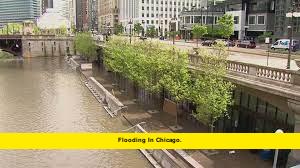The flooding in Chicago on July 8, 2025, brought the city to a standstill as nearly six inches of rain fell in less than two hours. Flash flood warnings were triggered across downtown, the West Side, and surrounding neighborhoods, leaving drivers stranded, viaducts submerged, and emergency crews overwhelmed. Streets turned into rivers as vehicles floated under overpasses, and residents scrambled to protect homes from basement flooding.
This sudden, high-intensity storm overwhelmed the city’s drainage systems, marking one of the worst urban flood events in recent memory. First responders raced to the worst-hit areas, where cars were stuck under several feet of water. Firefighters conducted multiple water rescues as officials urged citizens to stay off flooded roadways and avoid unnecessary travel.
Key Point Summary
- Rainfall totals exceeded 6 inches in some neighborhoods.
- Flash flooding shut down major roads and flooded viaducts.
- Emergency water rescues were carried out across the West Side.
- Basement flooding and sewer backups impacted dozens of blocks.
- Officials urged limited water use and warned of more rain ahead.
What Caused the Flooding in Chicago?
The flooding in Chicago was caused by a slow-moving thunderstorm system that parked itself over the city during peak evening hours. The storm dumped rain at rates up to two inches per hour, quickly overwhelming the stormwater infrastructure.
Low-lying areas such as viaducts and intersections with poor drainage were the first to flood. Within 90 minutes, rainfall totals rivaled levels typically seen in 100-year flood events. The hardest-hit areas included neighborhoods near Douglass Park, the Near West Side, and parts of Humboldt Park, where streets were submerged and multiple vehicles were stranded.
Flash Flood Chaos on the City’s West Side
The West Side bore the brunt of the flooding in Chicago, with major intersections turned into lakes. Commuters were forced to abandon their vehicles, and others were trapped beneath underpasses filled with brown, debris-laden water. Residents described the scene as “instant chaos,” with water rising so quickly that escape was nearly impossible.
City workers used portable pumps and emergency gear to clear flooded intersections. Meanwhile, community groups and volunteers stepped in to help clear drains and check on elderly residents.
Citywide Response and Ongoing Concerns
City authorities activated emergency protocols, including street closures and alerts urging residents to stay indoors unless absolutely necessary. Public Works teams were dispatched across the city to clear drains, pump water from roads and basements, and restore blocked sewer lines.
Local officials asked residents to limit water usage temporarily to help ease the burden on the system. Garbage pickup, street cleaning, and city maintenance operations were suspended in high-flood zones to prioritize rescue and cleanup efforts.
The city’s tunnel and reservoir system—designed to reduce flooding—was overwhelmed by the intensity and speed of the rainfall, revealing weaknesses in infrastructure when confronted by extreme weather.
Chicago’s Flooding in a Changing Climate
While flooding in Chicago isn’t new, the scale and frequency of such storms are intensifying. Experts warn that climate change is increasing the likelihood of “cloudburst” events, where a month’s worth of rain falls in a few hours. As Chicago continues to urbanize, paved surfaces and aging drainage systems are less able to handle such extreme volumes of water.
Urban flooding disproportionately affects low-income neighborhoods, many of which were hit hardest in this event. City leaders are now facing renewed calls to accelerate investments in green infrastructure, updated stormwater systems, and emergency preparedness programs.
What You Should Do If You’re Affected
If your neighborhood was impacted by the recent flooding in Chicago, take these steps:
- Avoid flooded streets. Do not drive through standing water.
- Report property damage and sewer backups to the city hotline.
- Document everything for insurance and FEMA purposes.
- Turn off electricity in wet areas to avoid electrocution.
- Check on neighbors, especially seniors and those with limited mobility.
With the potential for more storms this week, Chicagoans are urged to stay alert, listen to local emergency broadcasts, and prepare for additional flooding risks.
The recent flooding in Chicago is a wake-up call about how rapidly weather patterns are shifting—and how unprepared many urban areas remain. From overwhelmed sewers to flooded homes, the city faces growing challenges that require stronger infrastructure, better warning systems, and a more informed public.
Residents are encouraged to sign up for emergency alerts, assemble flood kits, and take preventive steps to protect their property. As the city rebuilds and recovers, the resilience of communities will play a central role in navigating future climate events.
Don’t wait for the next downpour—act now to protect your home, help your neighbors, and stay informed as updates develop throughout the week.
